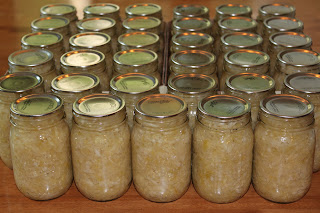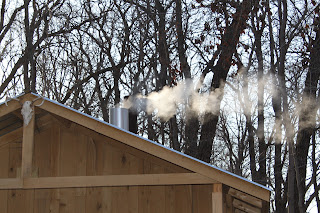It was the best of times, it was the wurst of times… it was sauerkraut season.
Sauerkraut is among the most unpleasant canning tasks we have. It is definitely the stinkiest. In a nutshell: we take an inherently unpleasant-smelling vegetable and let it ferment in our garage for three weeks. We start by shredding the cabbage with an old-school, antique three-blade kraut cutter into a 10-gallon crock. After the crock is completely full of shredded cabbage, we pack it down with a wooden ram until the top is covered with cabbage juice. Then we sprinkle in a handful of salt – a quarter cup or so. Then we fill the crock to the top again, tamp it until it’s under cabbage-water, salt it. Repeat. Repeat. Repeat until the crock is full. Then we set it aside to ferment for three weeks. Yes, that’s twenty-one days of stinkiness in our garage. Hey, at least we’re smart enough not to try to do it in the house! Over the fermentation period, the sugar in the cabbage turns to lactic acid, giving the sauerkraut its sauer-ness. Normally we’d actually let it sit there for four weeks, but this summer’s heat sped up the fermentation process.
The most important part of sauerkraut success (aside from making sure we have enough salt – mmmmm… salt…) is making sure no kraut is exposed to the air. Air + sauerkraut = a stinky, moldy mess. Ick. We’ve found that the best way to keep the air out is to cover the cabbage with a white kitchen trash bag full of water (double- or triple-bagged to avoid leakage). The water not only makes sure that the plastic is sealed into all the cabbage/crockery crevices to keep out the drafts, but it also puts some weight on the kraut to keep it submerged in the cabbage water for more even fermentation.
Sauerkraut is preservation method agnostic – frozen or canned, it tastes about the same to us. Since canned foods usually last longer than frozen ones, we decided to can the first 36 pints. But after those four batches, we were a little “sauered” on the canning, so we froze the rest, and we’ll just plan on using it first. Now that we have all these pretty jars of kraut, Jason’s looking forward to deer season to get some venison sausage to go with them!












